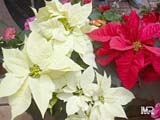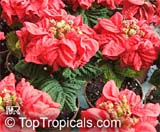MAGIC CHRISTMAS FLOWER
Alex Butova, Riga, Latvia (alexandrine@td.lv)
Source: TopTropicals.com

|

Cultivar "Winter Rose"
|
Who only did not write about this wonderful plant - Euphorbia pulcherrima - Milkweed the Finest or Poinsettia, one of the most popular and favorite plants. But every time just before Christmas when flower shops are offering these beautiful winter plants which shine as alive Christmas stars, I feel like writing about it a little bit more!
Everyone knows how the poinsettia looks now. But primarily it was a tall, slender shrub that grew up to 3 meters tall. It had large, dark green, oval leaves that were "toothed" on the sides and pointed at the tips. They emerge from smooth green erect stems. The plants naturally come into full bloom in November or December. The most common color is the deep, vibrant red. However, there is a wide array of other colors available, including pink, white, marbled, speckled and yellow. The colorful parts of the poinsettia, the bracts, are actually modified leaves. The poinsettia flowers are small, green or yellow, situated in the centre of the bracts.
Thanks to these star-looking bracts the plants are very attractive. First it was difficult to grow indoors these tall shrubs. Later as a result of selection works there appeared new compact sorts of poinsettia. Modern plants are more branchy, more decorative, their height does not exceed 30-45 cm and the blooming period lasts for two or three months.
The genus name Euphorbia was given in honor of antique physician Euphorb, who was the first to use its lacteal poisonous juice in medicine. The species name "pulcherrima" (the finest") was given for its extraordinary form of flowering. Poinsettia is a perfect houseplant. This milkweed unlike other succulents loves water and humid air and it can survive drought for a short time only. At the same time low temperatures combined with high humidity lead to all kinds of rot. If there is not enough light the colorful bracts are developing irregularly, and the leaves turn yellow and drop. Sometimes poinsettia falls a victim to whiteflies.
The poinsettia origins from Mexico. Aztecs named this plant Cuetlaxochitle. During XIV-XVI centuries bracts (modified leaves) were used to make a reddish dye and in cosmetics, also white juice of poinsettia was used to control fevers. When the new capital Mexico City was built, the last king of Aztecs Montezuma had ordered to bring poinsettia and to grow it wherein.
Further when the Mexican people had embraced Christianity, they began to name this plant "Flor de la Noche Buena" - Christmas Eve Flower. There was a heart-piercing legend how this flower became a symbol of Christmas. Once there lived the cousins Pedro and Pepita who did not have any gift to be brought to Church on the Christmas Eve. Children were walking to church and sighing, for they were poor and had nothing to welcome the Lord’s birth with. Then Pedro picked common weeds which were growing in abundance along the waysides and Pepita made a modest bunch of it. Children considered that even the most modest gift if presented with love might be given to the Lord. When they came into the church with this "bouquet" in their hands, weeds changed their color to red and green and all the churchgoers who attended the Christmas service understood that they witnessed the Lord’s divine miracle.
The name "Poinsettia" was given to Euphorbia pulcherrima in honor of Joel Roberts Poinsett who was the ambassador of the United States of America and an amateur botanist. In 1820 Doctor J. R. Poinsett was appointed the first ambassador of the USA in Mexico by president Andrew Jackson. At that time Mexico was involved in a civil war, the country was torn apart with internal contradictions. Though his basic mission was entangled and delicate, J.R.Poinsett also found time for his hobby. He introduced American elm into Mexico, and the plant had acclimatized finely. During all his stay in Mexico the ambassador never stopped wondering at the diversity of the plants he had never seen before. In 1828 wandering along a back street he saw a beautiful shrub with large red flowers. J.R.Poinsett was so impressed by the wonderful plant that in 1829 when he left Mexico City, he took cuttings from the plant and brought them back to his greenhouse in the USA. Thus this outstanding diplomat and a congressman will always be remembered for introducing Euphorbia pulcherrima in the United States.
Botanical name of Euphorbia pulcherrima was given to the plant by German botanist Wilenow. However a historian and horticulturist William Preskott suggested another name for Euphorbia pulcherrima - "Poinsettia", which became much more popular. At that time W.Preskott had just published the book called "Conquest of Mexico" and there was in this book detailed story about the ambassador Poinsett and his new plant. Later in the USA there was even established a new holiday – Poinsettia National day, fixed on December 12th - the day of J.R.Poinsett's death.
I won’t write about growing poinsettia, because there is enough written about it already. I only would like to point out two things.
First. When flowering period comes to its end the dormancy period starts. The plant drops its leaves and looks lifeless. At this point people simply throw it out. But if only you have some patience, it won’t be difficult to make poinsettia flower again. When the plant starts to drop foliage actively, it is necessary to prune it to a height of about only 10 cm. Then put poinsettia in a cool dark place and reduce watering. In the middle of May increase watering and repot the plant in a bigger pot with its root ball attached. Water regularly and fertilize the plant until new shoots appear. Leave only 4 or 5 shoots, removing all the rest. You may root the cut shoots, however first you’ll have to put them into warm water for 20 minutes in order to stop them milking. In September it is very important to maintain the proper light mode. The plant should spend in the darkness no less than 12-14 hours, so in the early evening you’ll have to cover your plant with dark lightproof material and remove it in the morning. Such mode should be supported for eight weeks, and just before Christmas wonderful flowers will appear again strong and beautiful.
And the second. Juice of all milkweeds is considered poisonous for human organism, so you may experience an allergy in case lacteal juice drops on your skin. Sometimes it may be nausea and diarrhea. So when working with poinsettia it is better to use rubber gloves.
Poinsettia is undoubtedly unrivaled in the holiday table decoration. You can use groups of potted specimens to bring color and warmth to entry ways and dark corners. Use them to decorate the base of the Christmas tree. The British botanists selected a new variety named "Winter Rose". It is a miniature plant, its bracts are like an old English rose, colored red, coral, pink, cream and white. When you see this flower for the first time you even can’t believe that it is really poinsettia.
Poinsettia is not costly and it is easy to care for. In dark winter time when everything is freezing outdoors, in this dark and uncomfortable season make a holiday for yourself - buy a beautiful poinsettia!
Literature:
Paul E.Ranch "The Poinsettia and its legend", Chiсago, 2001
Klug, S., Saleem, G., Hocharuk, L., Marcus, S. Toxicity potential of poinsettia, is the plant really toxic? Ottawa, 1990.
D.G.Hessayon "Home plants", London, 1994





